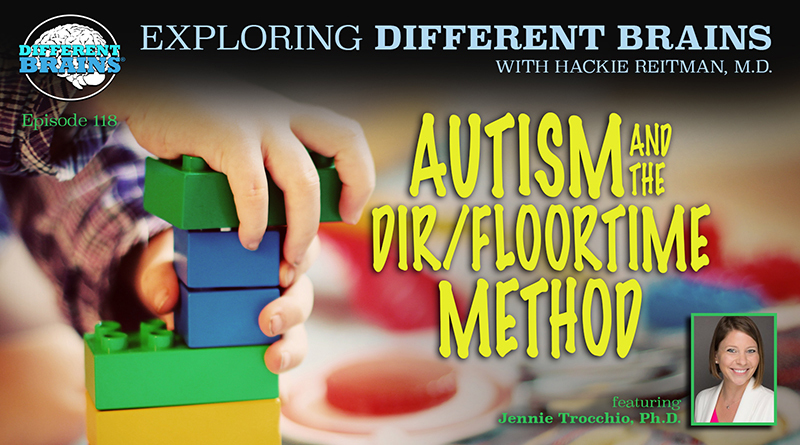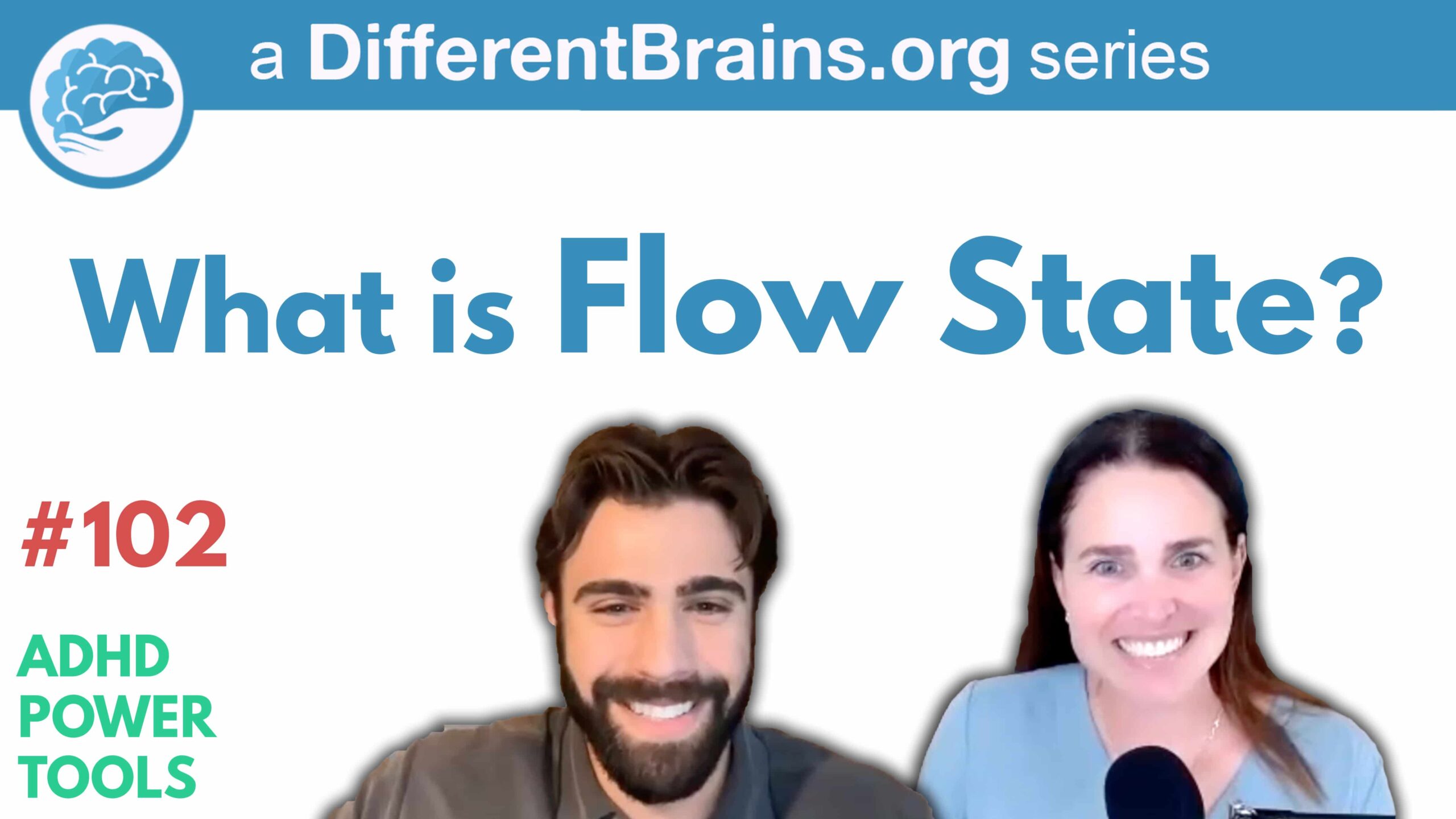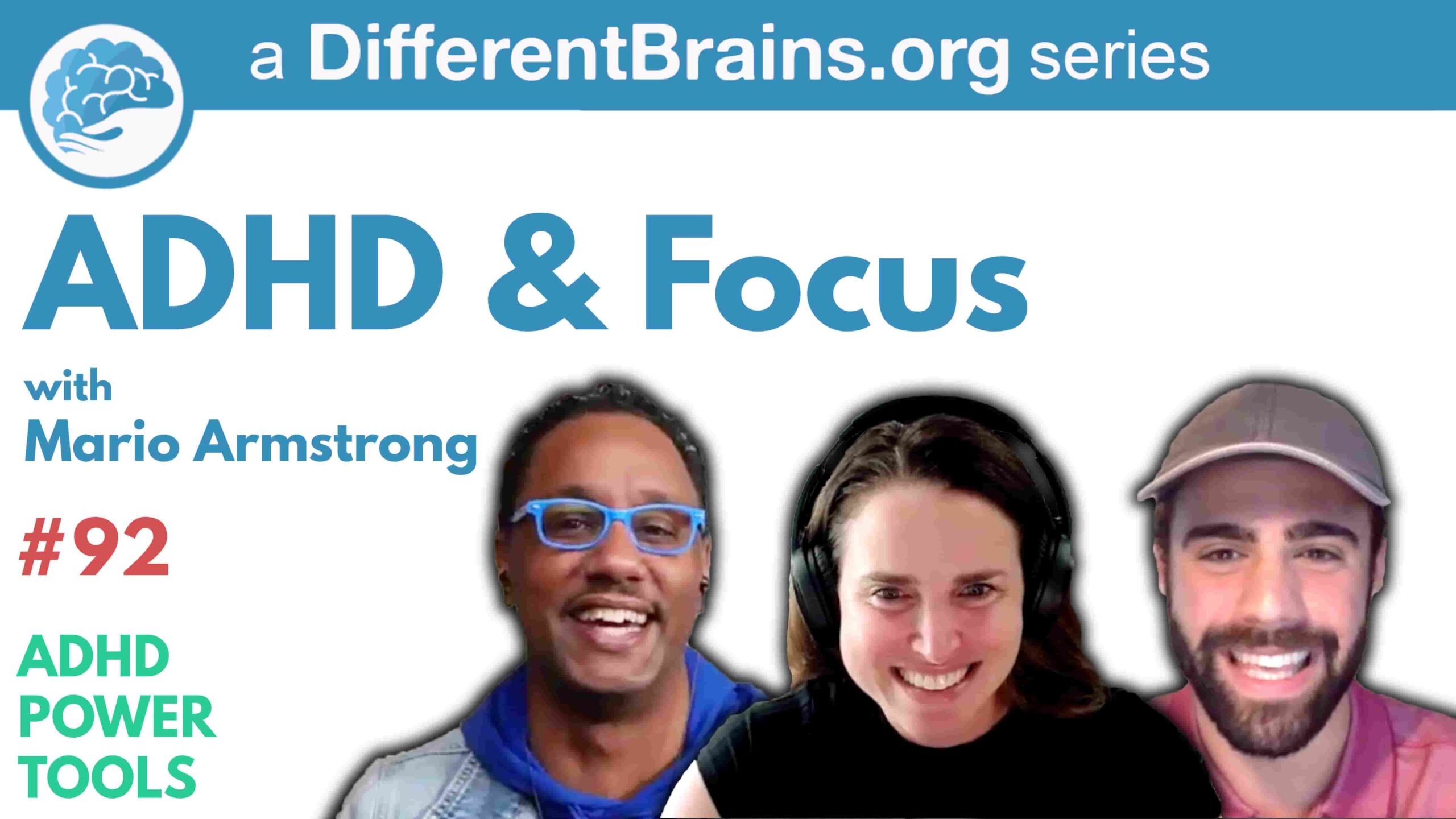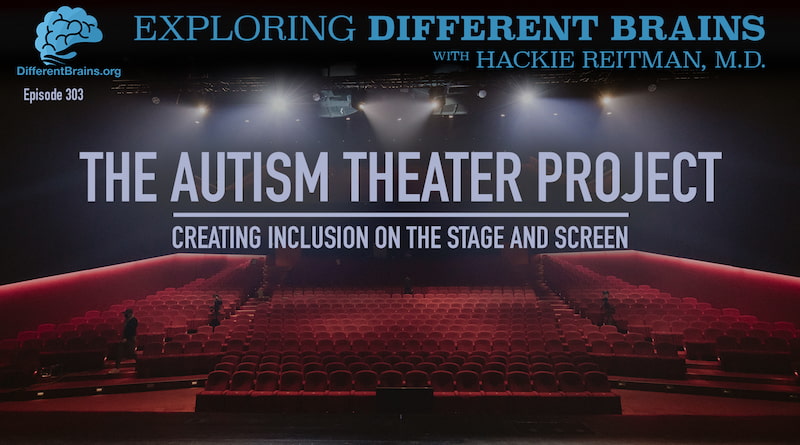
Autism and the DIR/Floortime Method, with Jennie Trocchio, Ph.D. | EDB 118
(22 mins) In this episode, Dr. Hackie Reitman speaks with Jennie Trocchio, Ph.D.. Dr. Trocchio is an autism educator, consultant, and DIR/Floortime provider. She explains what the DIR/Floortime method is, discusses how her time as a school teacher caused her to look for ways of better educating children, and talks about the importance of finding out what a child with autism is interested in.
For more about Dr. Jennie Trocchio, visit: www.drjennietk.com
.
78 Second Preview:
.
To listen or download the podcast version of this episode, see the embedded player below.
Or look for us on your favorite podcast provider:
iTunes | Stitcher | SoundCloud
[expand title=”View Full Transcript”]
HACKIE REITMAN, M.D. (HR): Hi, I’m Dr. Hackie Reitman. Welcome to another episode of Exploring Different Brains, and we have our friend Jennie Trocchio here. Jennie Trocchio is very interesting. She’s an autism education consultant, specialist, teacher, you name it, and she’s got some very special talents and experience we’re gonna discuss. Jennie Trocchio, welcome.
JENNIE TROCCHIO, Ph.D. (JT): Thank you so much, Hackie. It’s an honor to be here.
HR: Why don’t you, umm, introduce yourself?
JT: Sure, so, umm, as you said, my name’s Jennie Trocchio, and I’m an educator first and foremost. Umm, shortly after I got my undergrad degree I discovered autism and was so fascinated and so hooked into it, umm, and so curious by it because every child I met, they had the label of autism, they were completely different kids. Umm, so that kind of sent me down this mountain of trying to figure out what’s going on so I mean, I started, I enrolled in a master’s program, followed by a doctorate, reading every book you could possibly imagine, umm. After three years in the public school system, I started a school in Hollywood called Casablanca Academy, and there we used the DIR Floortime approach, which, umm, we’ll talk about in in a little bit, I have a feeling, but it was an incredible place to really find out what the kids needed. To figure out what was going on with them and to give them the experiences that they needed to really help them develop. And to be able to, you know, play in society a little bit more. Uhh, so I was there for about seven years, ran the school. And truly with the intention of spreading what’s working, spreading awareness, spreading tools, strategies, you name it, that work. To professionals, to parents, to kids, any way I can, I’m just trying to get out there and bring the community together a little bit.
HR: Well, we have a pretty sophisticated and growing Different Brains audience.
JT: I love that.
HR: So we’re gonna get the word out with you and I see a lot of possibilities for this because the more people I talk to who are affected by neurodiversity, whether it’s spectrum or other issues, umm, the more they’re not satisfied with the status quo. And we’ll get into that more later. Speaking of not accepting the status quo, explain to our audience, if you would, what DR, DIR Floortime is. What is that?
JT: Absolutely. Great question, because it’s not a, a simple answer. Umm, DIR stands for Developmental Individual differences and the Relationship-based approach and basically it is a practical and theoretical sort of framework for assessment, for intervention. And just kind of breaking that down a little bit, um, the D stands for development, so what we do is we look at where a child is developmentally. And that’s, pretty, and then we meet them there. And it sounds pretty, umm, self-explanatory, as though, “Of course, that’s what you should do; find out where someone is and meet them there,” but often, that’s not done, uhh, per se.
HR: Well, let me interrupt here to ask this.
JT: Please.
HR: To find where they are developmentally, but there’s another side to that, which is, to me, is the well-intentioned parents which many of us are that don’t want to connect on the individual’s own terms as a starting point. In other words, if someone is assessed with playing Legos, it’s like, “Oh, you gotta stop playing with those Legos!” instead of sitting down and playing the Legos with them, and I happened to have been using this very analogy recently, to the owner and his son, who’s taking over this huge development company, huge construction company. And I was giving that very Legos recently at a, a wedding, and they both looked at me like ._. and I said “What?” and the father said, “Ask him what I got him for Christmas.” And the guy’s now like 24. He got him a Lego set. He was completely enthralled with Legos and he went into construction. Instead of saying, “Stop talking about dinosaurs all the time,” maybe they can become a paleontologist. And so the first principle that you’re espousing is first connect.
JT: Yes. Yes.
HR: Ok, so now I’ll shut up because I’m sorry to interrupt.
JT: Well, actually you just kind of brought the rest of the framework together. So the I stands for individuality or individual differences. So find out what makes that child tick. How do they process the world? Are they into building things? Are they into, you know, mathematical equations? Are they into playing? What are they into? What do they like? And, and you have to take that into account. And then you also need the relationship. Umm, you need someone who’s there to say, “It’s ok. Let’s do this. This is fun. You’re amazing.” Everyone needs someone to say “you’re amazing”, because that’s what helps keep you going. You know? If someone’s telling you, “Stop that! That’s bad! That’s wrong!” You don’t want to hang out with them and you’ll find a way to do what you want to do, perhaps in a corner, perhaps by yourself, and I think that’s what’s happening with a lot of our kids is that they have amazing talents and they have amazing passions and instead of joining them in that and developing that, so often people are saying, “No, that’s wrong. That’s bad. Stop that. Go away.” Umm, and actually, that was one of the reasons why I ended up leaving the public school system. I remember I had a group of third grade boys who were amazing, as different as a group of third grade boys could be, umm, and, you know, we had this mandated reading curriculum where we had to be reading the third grade textbook, this page on this day, but my students didn’t know their letters. So I thought it would be a lot more appropriate to teach the alphabet in a fun way, you know? For, P is for pumpkin, we would take out pumpkins and, and get out the seeds, and really made it meaningful. Umm, and that wasn’t, that wasn’t thought to be ok. And I just starting thinking, “There’s a better way to do education.” And that’s really what, you know, started the school that’s using, that was using this approach of, “What does the child love to do? Let’s do it with them and turn it into an educational experience instead of forcing them to try to do things that are way above their level.”
HR: And not only above their level, but sometimes beneath their level.
JT: Yes, often.
HR: Making them read third grade level when they want to read, you know, Shakespeare. And, umm, uhh, to be able to connect, to be able to not have a one-size-fits-all system-
JT: Yes, yes.
HR: in our employment, in our schools, in everything we do. Another, uhh, thing that we don’t do that we do here at Different Brains with all of our neurodiverse interns, who are wonderful, who are putting out great media, doing great stuff, is to expose them to all different stuff, which our system doesn’t.
JT: Yes.
HR: So right here at, uhh, Different Brains, they’ll try shooting-
JT: Yesssss.
HR: They’ll try video editing; they’ll try transcribing; they’ll try researching stories, creative writing. And we have, umm, one intern, who, uhh, came to us with a film degree and was going to be a director and filmmaker and he’s now back full-time up at University of South Florida taking psychology. He’s in love with it, ok. It’s his passion.
JT: Mhm.
HR: Discovering your passion is something we don’t look for, too.
JT: Yesssss.
HR: And, if you’re lucky, you have one, and then if you’re really lucky, it’s nurtured instead of getting slapped down.
JT: It’s so true. And actually, a story on that same note of so often it’s under the level and we’re expecting everyone to fit into this box, umm, at Casablanca, at the DIR school right here in South Florida, umm, one of our students. Well, we had a bunch of students who were nonverbal, and often it’s assumed that if you’re nonverbal, then you’re non-intelligent. And that’s an unfortunate, I think, just kind of motto that our society has somehow come to. But it’s absolutely not true. So as we were finding ways to get these kids to communicate, umm, and this whole year there were behavior problems that I’m teaching these kids, you know: “A is for apple. Find the apple,” and they were like chucking the apples back at my head. Umm, and once we got them communicating, one of the boys, I remember, said, umm, typed out for me, he said, “I don’t care about this stupid stuff; I want to learn about Barack Obama; he’s my hero.” And this is a boy who everyone was assuming, you know, his academic developmental level was way down here. And so I said to him, I said, “How do you know about Barack Obama?” -and this was when Obama was our president- and he typed out “NPR”. And I just thought, “Wow.” You know? So often our kids are taking in everything, and that’s why those experiences are so important. You have to expose kids to everything, because they’re taking it all in and then just find what they’re connecting with.
HR: Let’s umm, give some specific examples, because I remember uhh, you showing me and sharing with me how you can, as a communication specialist, take someone who is nonverbal who wouldn’t type on a computer, and you would sit them a certain way and tilt them a certain way, and you support their arms a certain way, and they were prolific creative writers?
JT: That’s a great question, umm, and it’s also, I just want to put it out there, it’s a little bit controversial. Umm, but, what I found from I would say the majority of the kids I interact with who are non or limited verbal, so often it’s a motor planning challenge that’s impeding their ability to verbally communicate. So, umm, there’s a method called “supported typing” where the principle, umm, is that you provide backwards resistance to a child’s hand, to slow them down. So often, kids, you know, have an iPad or something like that in front of them; they’ll just kind of push all the buttons that they possibly can, because it’s fun and because, umm, impulsive and because sometimes it makes a sound or it does something, and it’s just kind of a fun way to, umm, kind of stem out a little, but if you just give them a little bit of backwards resistance to their hand, so you’re not guiding their hand, but just help them feel their hand and slow them down. So instead of typing like this, you know, you’d really provide them resistance to help them focus in on the keys that they want to type. And then, all of a sudden, they start realizing, “Ok, I’m actually communicating for the first time in my life,” and it makes them really focus on it more. And the more you practice, the better they get at it, and next thing you know, a lot of these kids who everyone kind of pushes aside and says, you know, huge judgmental things about their intellectual. Can you see how frustrating this is to me? Umm, but people really make judgments about their intellectual ability all based on their ability to speak, and I don’t think that that’s accurate. And if we find ways to get each child communicating, and sometimes it’s a little bit different for each child, but they can communicate, and they’re taking so much more than we give them credit for.
HR: What would you say, just to play devil’s advocate, to the, the people who might say everything you’re doing is “not preparing them for the real world”? How do you respond to that?
JT: I mean, that’s like saying teaching a-a baby to speak isn’t preparing them for the real world. That’s completely inaccurate. You know, we all-
HR: Well, for me it’s, it’s for me it’s more like, like I wear hearing aids. It’s like saying, “Well, if your student is deaf, you should just holler at them,” or “If they’re blind, write on the blackboard and holler at them.” I mean, I’m all about, and, and our book Aspertools, was designed for-
JT: Which is wonderful.
HR: Thank you very much. Was designed not to give scientific anything, it was, “Here are some tools that don’t cost anything you can really use to help any neurodiversity. Really,” and I think that the results orientation that you come from is the proof of the pudding to me. And what kind of, let’s talk about some of the results you get. Give us some, if you could, some. Because the way my brain is wired, I like specific cases and then I proceed to the general. Give us some specific examples.
JT: Well, in the case of the boy that I was mentioning earlier, where everyone kind of assumed that he, he didn’t know anything, that he didn’t know his letters, because if you just gave him letters, umm, he would just kind of want to touch all of them, but with a little bit of support, he could really narrow it down. Umm, since then, that boy, I mean, he can write essays that are so far beyond what often I see now at a college level. I mean, they’re insightful; they’re thoughtful. Umm, he’s able to see the world from a completely different perspective and I think that we all benefit from hearing other people’s perspectives, because it reminds us that we are all totally different people. Different things make us tick. And sometimes we need other perspectives. They need to be heard; they need to be shared.
HR: In light of the example you just gave, I want to, uhh, uhh, tell our audience about, umm, Matteo Musso, who I met him and his mom and family when I was, uhh, uhh, speaking out at the, uhh, United States Asperger’s/Autism Association in Portland, Oregon. And he puts, he’s nonverbal, and he writes poetry; he writes books, and he puts out a video, uhh, every Monday, “Mondays with Matteo”, where he communicates through his mom and through a-
JT: A device.
HR: …a typing board and everything. So it’s a matter of how you get there, and, not judging a book by its cover, that because somebody is nonverbal, they’re stupid.
JT: Mhm.
HR: As an example.
JT: Absolutely.
HR: Not that I like the word “stupid”. I’ve been called stupid a lot. Umm, umm, expanding upon that, in the best of all worlds, how would you like to see your method, your approach, umm, be used in society in the educational, uhh, community and in the employment community?
JT: Such a good question. Umm, so in terms of the employment community, I’ve recently seen some developments. So there’s an organization called “Picasso Einstein” and what they do is they take a child’s passion, what they love to do, what they’re doing anyway, and turn them in, turn them into entrepreneurs so that they’re starting their own businesses based on what they love. So that is really powerful to me. Umm, then when it comes to, ok in schools, I have so many ideas, umm, for schools, I’m in a lot of schools. One of the things I find myself saying a lot is that worksheets are not a learning style, because what I see happening in schools is all of the sudden, everything is a worksheet. The way they teach things are worksheets; the way they assess kids are worksheets. No one learns through worksheets; no one learns through textbooks. Learning should be meaningful and experienced and fun. And if you think back to, you know, all of the lessons that you really remember from school, even though it’s a long time ago, you still remember things that were meaningful. Maybe they were hands-on; maybe there was emotional connection to it. I remember one year, I was trying to teach a group of boys about lions, about animals, and it wasn’t really sticking and I was doing it, I was an early teacher and I was doing it in not a great, effective way, but in the way I thought I was told you were supposed to do it, and no one was really getting it. And then we took a trip to the zoo and we’re at the zoo, and there’s these huge glass cages, and the lion got right up to the glass, so me and my students were pretty much nose-to-nose with this lion-
HR: Wow.
JT: …who then jumps up onto the glass so his paws are right up there “Raaaagh!” and does this wild roar, and, and you know, we came back to, to school later that day, and I said, “Ok, so what did you guys think about the lion?” And then all the sudden, the language that I was hearing from these boys was amazing. They said “Oh, they’re the most ferocious animals in the jungle!” and “Did you see the size of their teeth?” and then another one kind of said “Don’t worry, there was a protective glass casing.” So you could see that they got so much out of the meaningful emotional experience, and I think that learning needs to be a lot more about that.
HR: What do you think can be done right now in the educational system as it really exists now to, uhh, go more along with your philosophy of thought process?
JT: Well, I think one of the big things that they could do is giving teachers more flexibility to teach things in ways that they would find meaningful. Right now, I think everything’s so scripted in schools. Umm, they have to be on this page at this time, and it’s loosened up a little bit in the past few years, but not a lot, and teachers really have a pressure of getting through X amount of stuff and they don’t have that professional; they’re not really treated as professionals who have trained to do this. They have not, they know how to teach it in an effective way. So I think giving them more of that flexibility. And then also, the movement piece is pretty big. Allowing them to have time for movement breaks, recess, you know? Opportunities to feel their body, to move, to interact with other kids, you know? One of the things I’m doing right now is I do, umm, professional speaking for summit professional education, so every month, they send me to a different state, and I do four workshops, umm, in each state. And what I love about that is I’m getting trends from different areas. And one of the trends right now, it seems to be sweeping the country, that terrifies me, is silent, seated lunches. And that’s something that’s being adopted by schools everywhere so that the kids can focus on eating and not get distracted and eat in a very efficient manner. But that, to me, is so scary, because mealtime should be a time to interact, and especially for kids who have trouble interacting, to work on this. You know, not in an isolated speech room. Umm, they need opportunities to interact with one another. To-
HR: Especially with all the evidence based studies now available for any neurodiversity, from autism to Alzheimer’s and all brains in between.
JT: Mhm.
HR: Socialization-
JT: Yesssss.
HR: …is probably the most important aspect for all of our health. Whether cancer, whether, doesn’t matter if you’re talking about cancer, heart disease, dementia, autism, brain development. And there’s plenty of studies now that are evidence based that show this. So we, we, I wasn’t even aware until just now of this silent lunch thing.
JT: Isn’t it horrifying?
HR: It is. It’s very 1984 George Orwellian.
JT: Yes.
HR: It really does. Maybe then the Thought Police will really come in.
JT: I’m hoping someone will step in. Someone’s got to. And then another thing in schools I’m seeing a lot is, you know, when kids act out or move too much in class, the punishment is to take away their recess. And that just baffles me. Actually, I did recently visit Massachusetts, and it’s actually illegal there. That’s the only place I’ve ever seen where they said “No, it’s, it’s law, you cannot-
HR: Wow.
JT: …take away a child’s recess for misbehaving, because usually they’re misbehaving because they need to move or they need to-
HR: Hmm.
JT: …interact, and we want to foster that.”
HR: Jennie, if people want to get ahold of the great Dr. Jennie Trocchio, how do they do that?
JT: Well, umm, the number one way people happen to find me is to Google me, so feel free to Google “Jennie Trocchio”, J-E-N-N-I-E T-R-O-C-C-H-I-O, Jennie Trocchio. Umm, I also have a website, umm, Autism Education and Development Solutions. I also have a Facebook page, Twitter, so really, using those two pieces, Jennie Trocchio and Autism Education and Development Solutions, you will be able to find me.
HR: Well, Dr. Jennie Trocchio, thank you for being with us, and we’re going to have to continue this conversation. Thanks again for taking the time to be here at Different Brains.
JT: Of course, and it will be an honor to continue this conversation whenever you would like. Have a great day.
[/expand]
.




